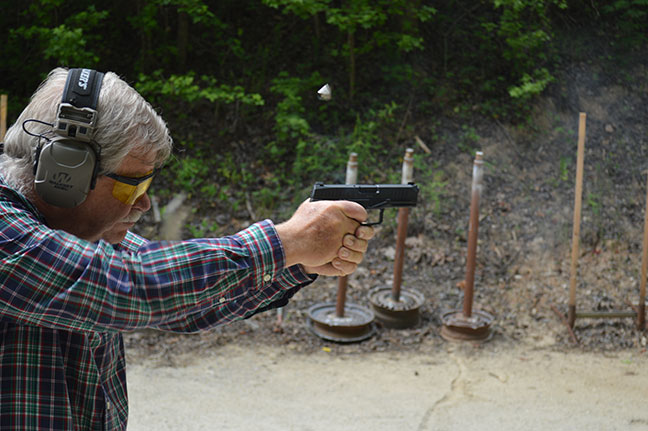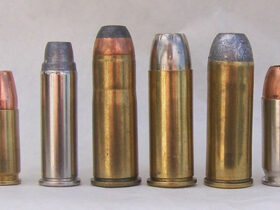Some of the folks criticizing police agencies for qualifying only once or twice a year don’t achieve much more in their personal training. Often enough, they are only making brass. It isn’t a good idea to let your perishable skills do just that — perish. Don’t lose sight of the goal.
The goal is to become a formidable individual capable of defending yourself or your loved ones. Looking over the last two dozen or so shootings covered by the national news, I can qualify and accurately access that the assailants were a mixed bunch, and all were dangerous.

The two worst possible characteristic traits in a human being are mean and stupid. There is no shortage of individuals with this combination. The dangerous assailants demonstrated a mix of low intelligence, intoxication, a variety of psychological disorders, and in at least one case, senility. Alcohol and drug abuse often cause a loss of inhibition and desperation. It isn’t pretty.
Depending on where you live, the chances of a violent assault are greater than ever. By the same token, even if the mathematics of statistical probability are in your favor, the possibilities are endless. After many years of study and more than a little personal experience, I find the single deadliest element in citizen deaths is complacency. Complacency and a lack of training may lead to a bloody terminus.
Let’s view the handgun and achieving proficiency as a needed skill akin to learning to change the tire on your vehicle. (Many lack this basic skill. Not that they are snowflakes, but no one taught them.) You hope you don’t need this skill or gear. However, when you do, you need the skill badly.
One individual will stand on the edge of a macadam road with no phone service and cry for help. The other gets the business done and goes about his day. “Ok.” you say, but it is easier said than done. Even those who are flush with funds cannot find enough ammunition. Fair enough. I have developed a set of drills that uses less ammunition. This isn’t ideal, but we must deal with the current situation and our budget.
I have strived to maintain my personal skill level and maintain my livelihood of testing and evaluating firearms as well. It hasn’t been easy. One resource I once heavily relied on was handloads. Without primers, handloads are no longer a resource. It is getting better in some ways, but in others the situation remains tight. Let’s look for solutions.

Dry Fire Training
I fire a handgun every other day on average. That is a lot of time behind the trigger. I seem to shoot better when there is more dry fire time behind the work. When I dry fire, I do so at home using a triple-checked, unloaded firearm. I aim for a certain spot or a red dot on the backstop — and you must have a backstop, live ammo or not — and I practice the drill.
I have extended these drills to range work. Before running through a drill or firing the handgun, I practice getting on target, aiming, and pressing the trigger. It is like a whole new stratum of training. Dry fire at home, dry fire at the range, and finally live fire using ammunition.
Keep a good sight picture and practice the trigger press. When the hammer falls, look at the sights and determine whether the sights were on target when the hammer fell. Be certain to not jerk the trigger. Press evenly to the rear. There will be no muzzle blast or recoil during dry fire, so you will concentrate purely on the trigger action. Get plenty of dry fire time. It isn’t wasting time to dry fire at the range — far from it. It is a warmup and essential to skills building.

When you must respond to a threat, you need a mix of speed and accuracy. This means the presentation from concealed carry must be practiced. You bring the handgun from concealment and into a firing stance that will lead to a hit on the target in practice or shot into the threat if the action is real.
You practice the draw without dry fire and with dry fire. Mix up the sequence. The drill should become imbedded in muscle memory. As you draw, step off the X (off the line of fire).
Fortunately, most criminals don’t shoot accurately. In my hometown, two groups at odds with one another — let’s just say they were part of the other gun culture — fired 117 shots at each other. They managed to hit one person — an innocent bystander.

Get off the X and create distance when possible. Incorporate this movement into the draw. Begin practicing the presentation only. Become smooth, and progress to moving off the X and out of the line of fire.
Ensure the holster is properly attached to the belt, the holster is the right type for the handgun, and for the concealed carry role. If the holster binds on the draw, the gun drags, or the handgun is difficult to re-holster, something is wrong and must be addressed or changed. Draw the handgun from a stable firing stance and lead the handgun to the target. It is as simple as that.
The presentation is more than a fast draw. It is presenting the handgun from concealed carry to the threat. We are getting the handgun into action and addressing the threat by assuming the firing stance and taking aim at the threat.
Firing Drills
While you need to practice the presentation and then lead into firing at the target, marksmanship may be practiced separately from presentation. Since many ranges prohibit drawing from concealed carry, and I do not really blame them, you may be in the position of practicing the presentation at home and marksmanship at the range. Shot placement is everything. Speed comes with smoothness. Concentrate on accuracy.
Fire three rounds. Each shot is a separate event not a string. Always keep that in mind. The best indication of your accuracy potential is firing at a standard target at 7–10 yards. Most handguns are regulated for the six o’clock hold at 10–20 yards. At 5–7 yards, some handguns fire a little low.

Don’t aim for an area, aim for a finite point on the target. A bullseye target may not be a combat target, but it is very useful for training. Be certain you are getting on target and hitting what you are aiming at. It is that simple.
Firing a magazine at a target isn’t training. You may have a nice little group, or you may have fliers. Which was the shot that hit the target? Firing fewer shots tells you more about marksmanship. Recoil control is easily practiced with fewer rounds.
Limiting ammunition for certain drills makes sense. As an example, a standard Failure to Stop drill has been to fire two rounds to the chest and then two to the pelvic girdle. This is a good drill that should be practiced often. If you are short of ammunition, fire a single shot to the chest and then one to the pelvis.

I think there is more stress when you have less shots and more motivation to fire accurately. This is cutting it short, however. I like the two to the chest and two to the pelvic girdle drill when I have a sufficient ammunition supply.
There is also a school that advocates a shot to the cranial ocular cavity when the shots to the chest do not show immediate effect. The head is a very difficult target and will probably be in motion during a gun fight. It isn’t as sure a hit as you may think. Shots to the side of the head or high shots have little effect, and the jawbone is famous for absorbing heavy hits. If you have a shot, take what you have but the failure to stop drill is generally best practiced in the shot to the chest and shot to the pelvic girdle drill.
There is an old saying that speed is good, and accuracy is final. I think ammunition shortages point out some flaws in training that are being reluctantly addressed. Perhaps, we will become better shooters in the end result.

I have often pointed out that hosing down a target with ammunition proves nothing, does nothing, and is counterproductive. When you have lower capacity firearms, such as a revolver or a single-stack automatic, the reality of the situation must set in. Training to empty the gun into a target is counterproductive, especially if you may one day face multiple assailants.
Fire for the center of mass or the arterial region and make a good hit. Then, get another hit. Practice firing at two targets quickly. Fire, swing to the next target, get a hit, swing back, and so forth until the firearm is empty. Master this and you will have learned how to move the pistol and get hits on multiple targets.
Part of the routine I conduct is firing for accuracy from a solid benchrest firing position. I test subcompact and snub nose handguns at 15 yards, and larger handguns at 20–25 yards. A five-shot group was once standard for handguns, while a three-shot group was standard at 100 yards for rifles.

I fire three-shots with the handgun these days. I learn about the relation between the point of aim and point of impact, and I learn the handgun’s potential accuracy. If I pull a shot, I know that I pulled the shot. If I did not pull a shot, then I have a good indicator of accuracy potential. Human error is more likely the more shots I fire. That’s ok in training, it points out shortcomings. When testing for accuracy, I need to take every advantage.
Proofing Handguns
I like to use proven loads when testing a new handgun. When testing new loads, I like to use proven handguns. See the logic? There are always new loads and ammo makers. Many are excellent loads perform well, but not all. Factory fresh ammunition from Federal, Hornady, Remington, Speer, and Winchester are going to feed and cycle, or the pistol is sick.
I like to confirm reliability with at least two magazines of ammunition. This also confirms the point of aim and point of impact relationship. The days of laying a $100 bill on the counter and walking away with enough ammunition to practice and confirm reliability with hollow point loads is gone forever. However, we may practice enough to keep our edge — if we watch the supply and stay sharp.
Do you have a training plan that reduces your ammo count? How much training time do you spend with dry fire practice? Share your answers in the comment section.
Editor’s note: This post was originally published in July of 2022. It has been completely revamped and updated for accuracy and clarity.
Source link: https://blog.cheaperthandirt.com/shooting-tips-training-with-less-ammunition/?utm_source=rss&utm_medium=rss&utm_campaign=shooting-tips-training-with-less-ammunition by Bob Campbell at blog.cheaperthandirt.com








